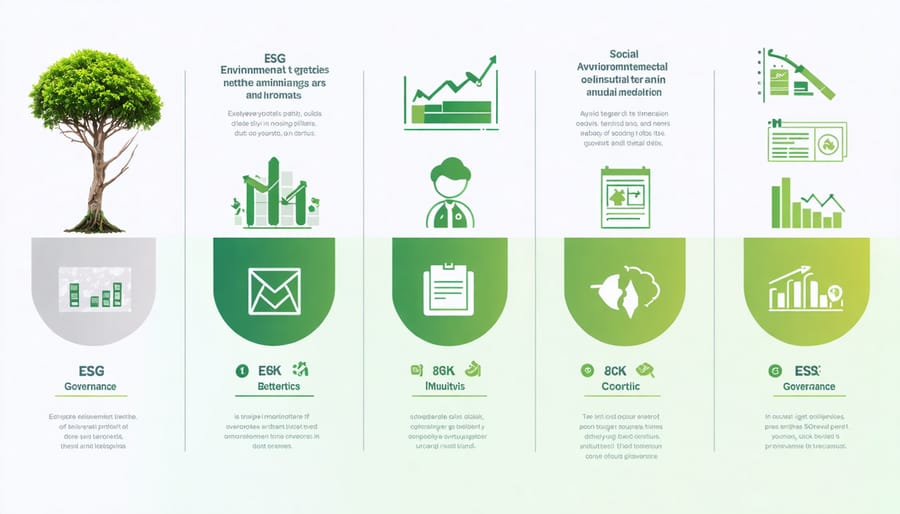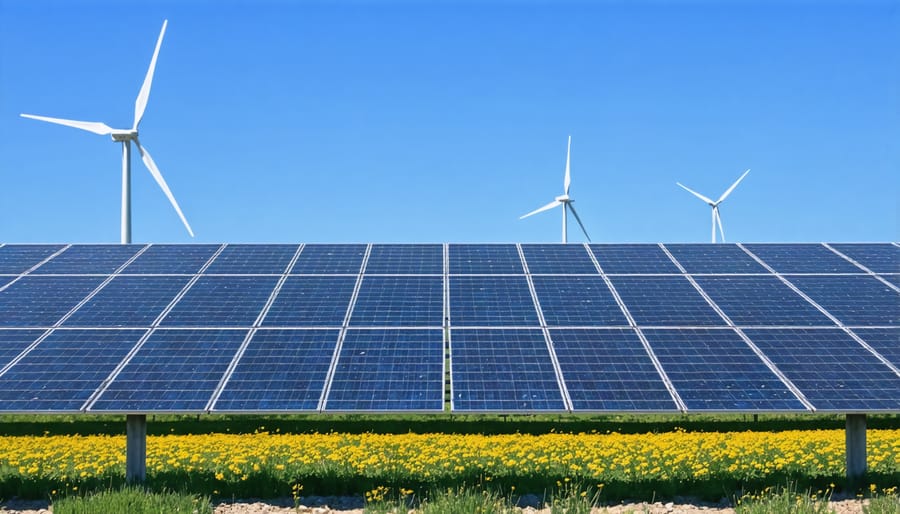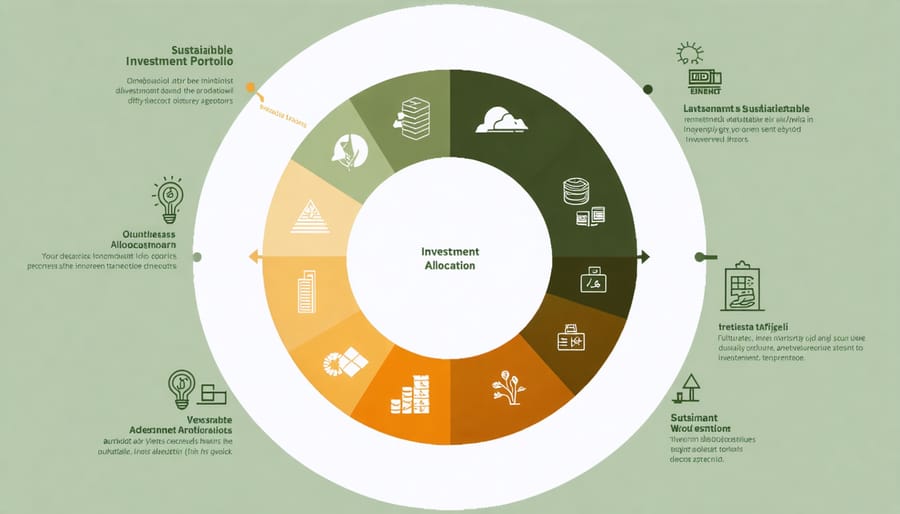Transform your investment portfolio into a force for positive change while maintaining robust financial returns through strategic sustainable investing. Canadian investors now recognize that environmental, social, and governance (ESG) factors directly impact long-term business success and market performance.
Leading Canadian financial institutions report sustainable investments consistently outperforming traditional portfolios, with ESG-focused funds demonstrating remarkable resilience during market volatility. From clean technology ventures to renewable energy projects, opportunities for sustainable investing continue expanding across the Canadian marketplace.
Modern sustainable investing extends far beyond simply excluding harmful industries. Today’s sophisticated approaches integrate comprehensive ESG analysis, impact measurement, and engagement with company management to drive meaningful change while generating competitive returns. Whether through direct investment in green bonds, ESG-screened mutual funds, or cleantech startups, Canadian investors can align their portfolios with both their values and financial goals.
For business owners and institutional investors seeking to capitalize on the sustainability revolution, understanding key ESG metrics, regulatory frameworks, and emerging opportunities in the Canadian context is essential. This guide explores proven sustainable investment strategies, risk management approaches, and government incentives to help you build a future-ready portfolio that delivers both purpose and profit.
The Rise of ESG Investing in Canadian Markets

Key ESG Metrics Canadian Investors Track
Canadian investors closely monitor several key ESG metrics to evaluate sustainable investments effectively. Environmental indicators include greenhouse gas emissions, waste management practices, and involvement in circular economy initiatives. Companies’ carbon footprint reduction targets and renewable energy adoption rates are particularly significant in the Canadian market.
Social metrics focus on workforce diversity statistics, employee turnover rates, and Indigenous engagement practices. According to the Canadian Investment Funds Standards Committee, workplace safety records and community relations programs carry substantial weight in ESG evaluations.
Governance indicators emphasize board diversity, executive compensation transparency, and anti-corruption policies. The Toronto Stock Exchange (TSX) reports that companies with strong governance scores typically demonstrate better long-term performance.
RBC Global Asset Management highlights that Canadian investors particularly value:
– Climate risk management strategies
– Indigenous reconciliation efforts
– Gender diversity in leadership roles
– Supply chain sustainability
– Stakeholder engagement practices
These metrics help investors assess both the sustainability commitment and financial resilience of potential investments while aligning with Canadian values and regulatory requirements.
Canadian ESG Market Performance Trends
Canadian ESG investments have demonstrated remarkable resilience and growth over the past five years, with sustainable equity funds consistently outperforming traditional benchmarks. The S&P/TSX Renewable Energy and Clean Technology Index has shown an average annual return of 18.2% since 2019, surpassing the broader TSX Composite Index by approximately 6.5 percentage points.
Notable success stories include Canadian renewable energy companies like Brookfield Renewable Partners, which has delivered consistent returns while maintaining strong environmental credentials. The Canadian responsible investment market now exceeds $3.2 trillion in assets under management, representing roughly 62% of Canadian investment funds.
According to RBC Global Asset Management’s annual survey, 89% of institutional investors believe ESG-integrated portfolios perform as well as or better than non-ESG investments. This confidence is reflected in market activity, with Canadian sustainable bond issuance reaching record levels of $20 billion in 2022.
The emergence of clean technology and renewable energy sectors has created new opportunities for investors, with Canadian cleantech firms experiencing average revenue growth of 25% annually. These trends suggest a promising outlook for ESG investments in Canadian markets, supported by strong regulatory frameworks and growing investor demand.
Proven Sustainable Investment Approaches
Impact Investing in Canadian Companies
Impact investing in Canadian companies offers a powerful avenue for investors to generate both financial returns and positive environmental impact. Canadian green tech companies are particularly attractive targets, with many demonstrating strong growth potential while addressing crucial sustainability challenges.
Notable success stories include Vancouver-based Carbon Engineering, which has pioneered direct air capture technology, and Li-Cycle, a Toronto-based lithium-ion battery recycling company. These companies exemplify how sustainability-focused investments can deliver substantial returns while contributing to environmental solutions.
According to the Responsible Investment Association of Canada, impact investments in Canadian companies have grown by over 80% since 2018, reflecting increasing investor confidence in sustainable business models. Key sectors attracting impact investment include renewable energy, clean transportation, sustainable agriculture, and waste management solutions.
For investors considering this approach, several entry points exist. These include direct equity investments in private companies, participation in cleantech-focused venture capital funds, and investment in publicly traded sustainable companies on the TSX. Government incentives, including tax credits and grants for clean technology investments, further enhance the attractiveness of these opportunities.
Industry experts recommend conducting thorough due diligence, focusing on companies with proven technology, strong management teams, and clear paths to profitability. This approach ensures that investments align with both sustainability goals and financial objectives.

Green Bonds and Clean Energy Projects
Green bonds have emerged as a powerful vehicle for financing sustainable initiatives, particularly in Canada’s rapidly expanding clean energy sector. These fixed-income securities offer investors the dual benefit of competitive returns while supporting clean energy innovations and environmental projects.
Canadian institutional investors, including pension funds and asset managers, have shown increasing interest in green bonds, with the market experiencing a 35% growth in 2022. Major Canadian banks now regularly issue green bonds to fund renewable energy projects, energy-efficient buildings, and sustainable transportation initiatives.
For business owners and investors, green bonds offer several advantages. They typically provide stable, predictable returns comparable to traditional bonds while carrying the same credit rating as the issuer’s conventional debt. The Canada Infrastructure Bank has been instrumental in supporting these investments, offering co-financing opportunities and risk mitigation tools.
Notable success stories include Ontario’s Green Bond Program, which has raised over $2.5 billion for clean energy projects and sustainable infrastructure. According to RBC Capital Markets, green bonds issued in Canada maintain an average oversubscription rate of 2.5 times, demonstrating strong market demand.
For those new to sustainable investing, green bonds represent a lower-risk entry point compared to equity investments, while still contributing to environmental objectives. Many Canadian financial advisors recommend allocating 10-15% of fixed-income portfolios to green bonds for optimal diversification.
Sustainable ETFs and Mutual Funds
Sustainable ETFs and mutual funds offer Canadian investors an accessible way to align their portfolios with environmental and social values while maintaining professional management and diversification. These investment vehicles pool resources from multiple investors to create portfolios focused on companies with strong environmental, social, and governance (ESG) practices.
Several Canadian financial institutions have launched sustainable fund options, including BMO’s ESG Corporate Bond Fund and RBC’s Vision Fossil Fuel Free Global Equity Fund. These funds typically screen companies based on sustainability criteria while targeting competitive returns.
According to the Responsible Investment Association of Canada, sustainable investment funds have shown comparable or better performance than traditional funds, dispelling the myth that sustainable investing requires sacrificing returns. For example, the S&P/TSX Renewable Energy and Clean Technology Index has consistently demonstrated strong growth potential.
Key benefits of sustainable funds include:
– Professional management of ESG criteria
– Lower minimum investment requirements
– Automatic diversification
– Liquidity and transparency
– Regular reporting on sustainability metrics
When selecting sustainable funds, investors should consider factors such as management fees, historical performance, and specific ESG screening criteria. Many Canadian fund providers now offer detailed sustainability reports alongside traditional financial metrics, helping investors make informed decisions aligned with both their financial goals and values.
For those new to sustainable investing, these pooled investment options provide an excellent entry point while maintaining professional oversight and risk management.
Risk Management in Sustainable Investing
Due Diligence Process
A thorough due diligence process is essential when evaluating sustainable investments. Begin by examining the investment’s environmental, social, and governance (ESG) metrics through established frameworks such as the Global Reporting Initiative or Sustainability Accounting Standards Board guidelines. Review the company’s sustainability reports, carbon disclosure data, and third-party ESG ratings.
Analyze the organization’s commitment to sustainability by evaluating their long-term environmental goals, implementation strategies, and past performance. Look for transparent reporting practices and clear metrics that demonstrate progress toward sustainability targets. Consider the company’s industry position and how they compare to peers in sustainability initiatives.
Financial analysis remains crucial – examine traditional metrics like revenue growth, profit margins, and market position alongside sustainability performance. Assess how environmental and social risks might impact future returns and whether the company has adequate risk management strategies in place.
Engage with company management to understand their sustainability strategy and commitment to ESG principles. Request information about specific initiatives, measurement methods, and future plans. Consider seeking input from industry experts and sustainability consultants who can provide additional insights into the investment’s potential.
Document findings systematically and maintain a checklist of key sustainability criteria. Regular monitoring and updates to the due diligence process ensure alignment with evolving sustainability standards and market expectations. This comprehensive approach helps identify truly sustainable investments while managing risk effectively.
Portfolio Diversification Strategies
Portfolio diversification in sustainable investing requires a strategic balance across multiple sectors and asset classes to maximize both environmental impact and financial returns. A well-structured sustainable portfolio typically includes a mix of renewable energy, clean technology, sustainable real estate, and green bonds.
Canadian investors are increasingly adopting the “40-40-20” approach: allocating 40% to established sustainable companies, 40% to green bonds and fixed-income securities, and 20% to emerging sustainability innovators. This balanced strategy helps manage risk while maintaining exposure to high-growth opportunities.
Key sectors for sustainable diversification include:
– Clean Energy: Solar, wind, and hydroelectric power companies
– Green Infrastructure: Sustainable transportation and smart city developments
– Resource Efficiency: Water management and waste reduction technologies
– Sustainable Agriculture: Organic farming and precision agriculture solutions
Industry leaders recommend incorporating ESG-focused exchange-traded funds (ETFs) alongside individual stock selections to achieve broader market exposure. The Toronto Stock Exchange offers several sustainability-themed ETFs that provide instant diversification across multiple sectors.
To optimize portfolio performance, consider geographic diversification by including both domestic and international sustainable investments. This approach helps protect against regional market fluctuations while supporting global sustainability initiatives.
Regular portfolio rebalancing, typically quarterly, ensures your sustainable investments maintain their target allocations and continue to align with your environmental and financial goals.

Government Support and Incentives
Tax Benefits and Credits
Canadian investors engaging in sustainable investments can benefit from various tax incentives and credits designed to promote environmental responsibility. The federal government offers several tax advantages through the Clean Technology Investment Tax Credit, which provides up to 30% returns on investments in clean energy generation and storage systems.
Provincial programs add another layer of benefits. For instance, British Columbia’s Clean BC program offers tax credits for investments in energy-efficient buildings and renewable energy projects. Ontario’s Clean Technology Innovation Fund provides tax incentives for investors supporting early-stage sustainable technology companies.
Investment in flow-through shares of Canadian renewable energy companies can provide tax deductions of up to 100% of the investment amount. Additionally, capital gains from investments in certified clean technology companies may qualify for reduced tax rates under specific conditions.
Corporate investors can also benefit from accelerated capital cost allowance rates for clean energy equipment and sustainable infrastructure investments. These provisions allow businesses to write off sustainable investments more quickly, improving cash flow and return on investment.
Remember to consult with a qualified tax professional to maximize available benefits and ensure compliance with current regulations.
Grant Programs and Partnerships
Canadian businesses pursuing sustainable business models can access numerous government-backed programs and partnerships. The federal government’s Strategic Innovation Fund offers substantial support for clean technology projects, with funding pools ranging from $10 million to $50 million for qualifying initiatives.
Business Development Bank of Canada (BDC) provides specialized financing options through their Cleantech Practice, supporting companies developing sustainable solutions. Their program includes both direct investment and advisory services to help scale green innovations.
Provincial programs complement federal initiatives. For instance, Ontario’s Green Investment Fund and BC’s Innovative Clean Energy Fund offer matching grants and tax incentives for sustainable ventures. These programs typically cover 25-50% of eligible project costs.
Notable partnership opportunities include the Canada Infrastructure Bank’s Green Infrastructure stream and Export Development Canada’s cleantech support programs. These initiatives help businesses access international markets while maintaining environmental standards.
For emerging enterprises, accelerator programs like MaRS Cleantech and Sustainable Development Technology Canada (SDTC) provide mentorship and seed funding, fostering innovation in the sustainable business sector.
Sustainable investing in Canada has evolved from a niche market to a mainstream investment approach, driven by growing environmental awareness, strong regulatory support, and impressive market performance. The strategies discussed demonstrate that investors can generate competitive returns while contributing to positive environmental and social outcomes.
Looking ahead, the sustainable investment landscape in Canada shows tremendous promise. The federal government’s commitment to achieving net-zero emissions by 2050, combined with increasing corporate transparency requirements and standardized ESG reporting frameworks, creates a robust foundation for continued growth in this sector.
Canadian investors are well-positioned to capitalize on emerging opportunities in clean technology, renewable energy, and sustainable infrastructure. The success of major Canadian pension funds in implementing sustainable strategies provides a proven roadmap for individual and institutional investors alike.
Key considerations for future success include maintaining rigorous due diligence processes, staying informed about evolving ESG standards, and regularly reviewing portfolio alignment with sustainability goals. As sustainable investing continues to mature, we can expect more sophisticated investment products, improved measurement tools, and greater integration of sustainability factors across all asset classes.
The transformation toward a more sustainable economy presents both challenges and opportunities. By adopting well-researched sustainable investment strategies, Canadian investors can participate in this transition while potentially achieving superior long-term returns and contributing to a more sustainable future for generations to come.
